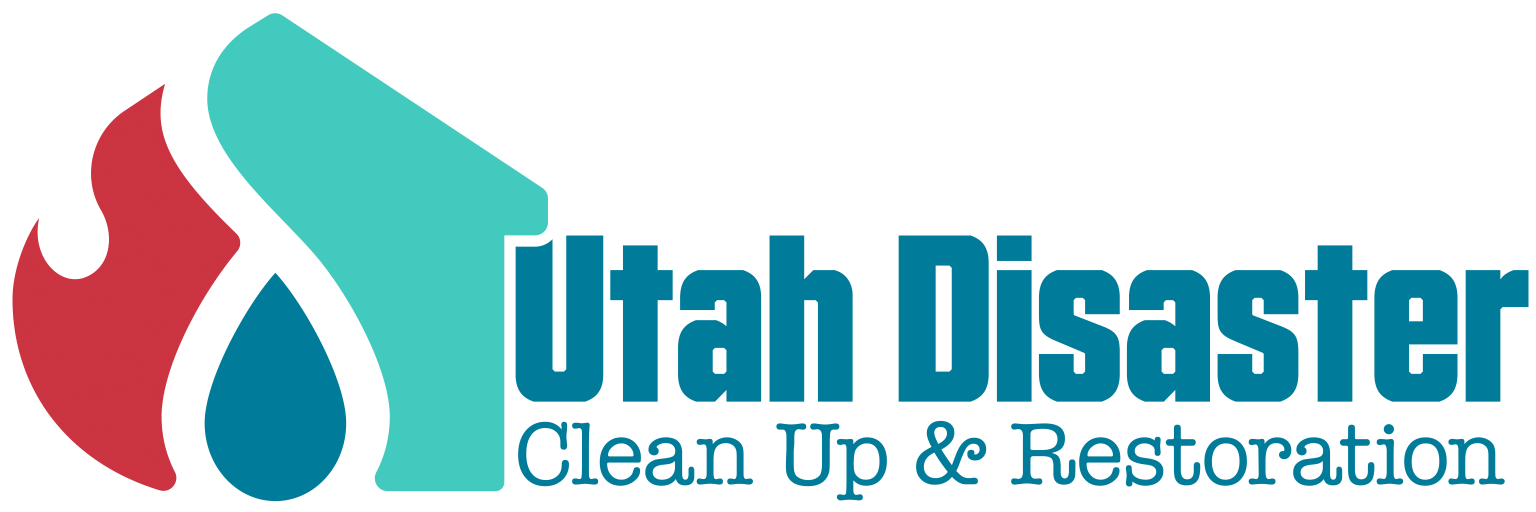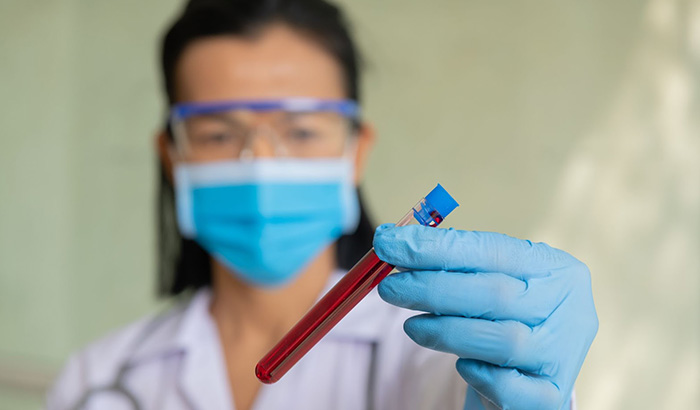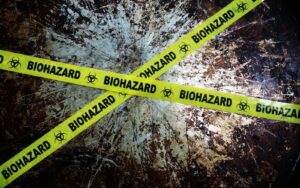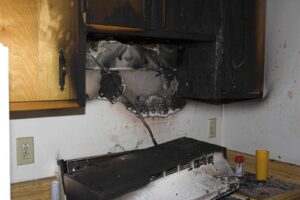Biohazard cleanup is crucial for removing, cleaning, and disinfecting materials contaminated by potentially infectious agents. Biohazard cleanup ensures the safety of public and environmental health. Central to this task is addressing the risk of bloodborne pathogens like hepatitis B, hepatitis C, and HIV, which pose significant health risks upon exposure.
These pathogens are especially concerning in scenarios involving human blood or bodily fluids, highlighting the importance of strict protocols to protect professionals and the public. Understanding and managing the risks of bloodborne pathogens is essential to maintaining safety during and after biohazard cleanup.
What are bloodborne pathogens?
Bloodborne pathogens, such as HIV, Hepatitis B, and Hepatitis C, are infectious agents in human blood that can cause serious illnesses, including liver disease and immune system impairment.
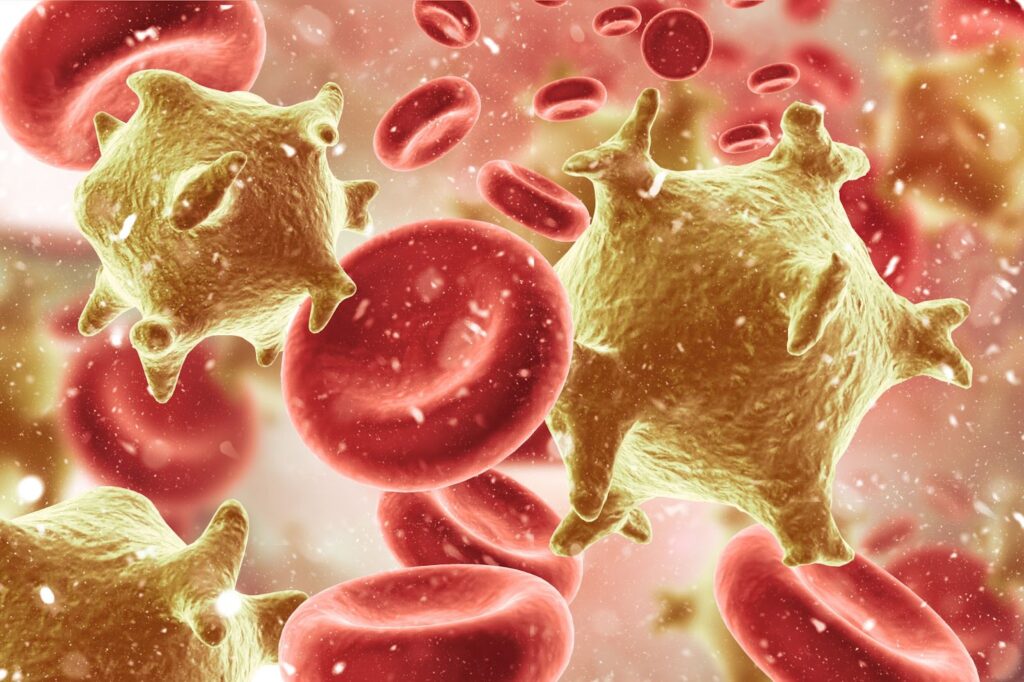
These viruses are transmitted through contact with infected blood or other potentially infectious materials (OPIM) via cuts, needle-stick injuries, or contact with mucous membranes. The risk of transmission is particularly high in biohazard cleanup scenarios, where exposure to contaminated materials is likely.
Understanding how these pathogens spread is vital for applying effective prevention measures, such as wearing protective gear and adhering to strict cleanup protocols, to minimize exposure risk and protect health during biohazard cleanup operations.
Risks associated with bloodborne pathogens in biohazard cleanup
Bloodborne pathogens pose significant risks during biohazard cleanup, threatening workers with serious diseases like hepatitis B, hepatitis C, and HIV.
These pathogens are able to survive outside the body, with hepatitis B remaining infectious on surfaces for up to 7 days, highlighting the importance of protective measures. Healthcare settings, where needle-stick injuries are common, illustrate the dangers, with the CDC reporting 385,000 such injuries annually among U.S. healthcare workers.
Exposure may lead to chronic illness, long-term medical needs, and considerable mental health impacts due to the stress of potential infection.
These realities underscore the necessity of stringent safety protocols, including awareness, training, and personal protective equipment, to safeguard cleanup professionals and the public against the risks of bloodborne pathogens in biohazard environments.
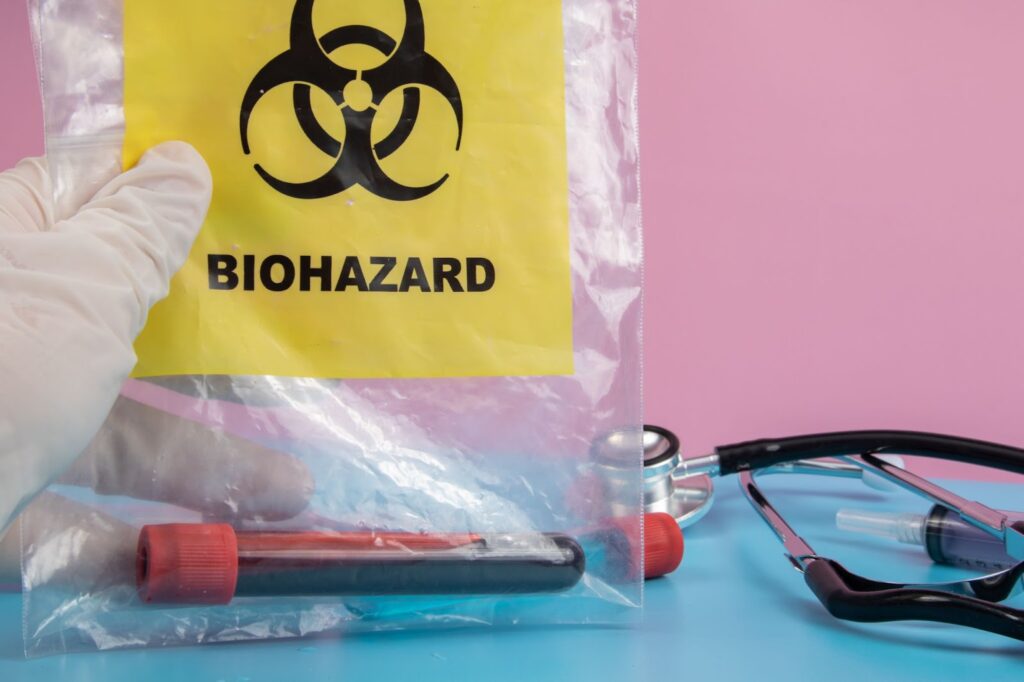
Key protective measures for handling biohazardous materials
Navigating the perils of biohazard cleanup demands meticulous attention to safety. Among the most effective strategies for safeguarding health are the use of personal protective equipment (PPE), adherence to rigorous training and protocols, and proactive vaccination and preventive care measures.
Personal Protective Equipment (PPE)
The proper use of Personal Protective Equipment (PPE) is essential in biohazard safety, acting as a vital barrier against hazardous materials. Gloves, goggles, masks, and protective clothing protect the skin and prevent infectious agents from entering through the eyes, nose, and mouth.
Choosing the right PPE requires evaluating the hazards and ensuring compliance with biohazard protection standards. Effective PPE use includes knowing how to correctly put the gear on and take it off, conducting regular inspections for damage, and ensuring a proper fit.
Additionally, training is crucial for personnel to effectively minimize exposure risks, highlighting the importance of both selection and proper usage of PPE in biohazard environments.
Proper training and protocols
Comprehensive training is essential for biohazard cleanup, focusing on understanding bloodborne pathogens, their transmission, and risk mitigation. Training encompasses safe handling, cleaning, and disposal of biohazardous materials, emphasizing safety from containment to disposal.
Cleanup protocols, which are crucial for protecting personnel and the environment, involve establishing containment zones, using disinfectants properly, and safely packaging and labeling waste. Following these meticulously designed protocols ensures a safe cleanup operation.
Vaccination and preventive care
Vaccinations are crucial for safeguarding cleanup personnel against bloodborne pathogens. The hepatitis B vaccine is strongly advised for those regularly exposed to blood or OPIM, offering significant protection against infection.
Knowing post-exposure procedures is essential. Following exposure, immediate actions like washing the affected area and seeking medical advice for potential treatment are key to quickly addressing any infections and reducing health risks.
These protective strategies ensure the safety of the cleanup personnel and contribute to the overall health and well-being of the communities they serve.
Legal and regulatory considerations
Biohazard cleanup requires understanding and adhering to legal and regulatory standards, notably the OSHA Bloodborne Pathogens Standard, which outlines guidelines to protect workers from bloodborne pathogens.
Employers must create an exposure control plan, identifying tasks with potential exposure to blood or OPIM and detailing actions to minimize this exposure. This includes providing PPE, bloodborne pathogen training, hepatitis B vaccinations, and outlining post-exposure procedures.
Compliance with OSHA’s standards is mandatory, emphasizing the employer’s role in maintaining a safe environment through regular plan updates, employee training, and accurate record-keeping of exposure incidents. These measures ensure worker safety and foster a culture of responsibility in biohazard cleanup operations.
Choosing a professional biohazard cleanup service
Selecting a professional biohazard cleanup service is a decision that demands careful consideration and scrutiny. The right service provider will bring expertise and efficiency to the task at hand and ensure compliance with all safety and health regulations, minimizing the risks associated with bloodborne pathogens.
Here’s what to look for when choosing a service that stands up to the challenge:
Certification and compliance
A reputable biohazard cleanup service should hold certifications from recognized industry organizations, such as the Institute of Inspection, Cleaning and Restoration Certification (IICRC). These certifications are a testament to the service’s commitment to following stringent standards for biohazard cleanup.
Ensure the company complies with OSHA’s Bloodborne Pathogens Standard, showcasing their dedication to worker safety and health.
Experience and specialization
Look for a service with a proven track record of handling biohazard situations similar to yours. Experience in the field translates to a deep understanding of the complexities involved in biohazard cleanup, from navigating the risks of bloodborne pathogens to employing the most effective cleanup techniques.
Specialization in crime scene cleanup, infectious disease decontamination, or chemical spill remediation provides additional assurance of the service’s capability to handle your specific needs.
Training and expertise
Comprehensive training is crucial for biohazard cleanup professionals to effectively mitigate the risks of bloodborne pathogens. Inquire about the training programs the service’s employees have completed, focusing on their knowledge of safety protocols, proper use of personal protective equipment (PPE), and emergency procedures.
Expertise in the latest cleanup technologies and methods further distinguishes a service’s ability to perform thorough and safe biohazard remediation.
Availability and responsiveness
Biohazard situations often require immediate attention. A service that offers 24/7 availability demonstrates a readiness to respond to emergencies at any time, providing peace of mind that help is available when you need it most. Prompt, reliable service is essential for minimizing health risks and restoring safety to your environment.
Reviews and references
Finally, don’t overlook the importance of reviews and references in gauging the reliability and quality of a biohazard cleanup service. Positive feedback from previous clients offers insights into the service’s effectiveness, attention to detail, and customer satisfaction.
Requesting references and speaking directly with former clients can provide firsthand accounts of their experiences, helping you make an informed decision.
Choosing a professional biohazard cleanup service is a critical step toward ensuring the safe and effective remediation of hazardous situations. By prioritizing certification, experience, training, availability, and client feedback, you will select a service that exceeds expectations, safeguarding health and safety with unparalleled expertise and care.
Trust Utah Disaster Clean Up for expert biohazard remediation
Navigating the aftermath of a biohazard situation demands expertise and a deep commitment to safety, compliance, and compassion. As we’ve explored the critical factors in choosing a professional biohazard cleanup service, one name stands out for its unwavering dedication to these principles: Utah Disaster Clean Up.
With years of experience in the field, Utah Disaster Clean Up brings an unparalleled level of specialization and expertise. Our team of certified professionals is equipped with the knowledge and skills necessary to tackle even the most challenging biohazard scenarios, ensuring that all health risks, especially those posed by bloodborne pathogens, are effectively mitigated.
Adherence to OSHA’s Bloodborne Pathogens Standard and continuous training in the latest cleanup technologies are only a few of the ways we demonstrate our commitment to safety and excellence.
Utah Disaster Clean Up’s 24/7 availability means we’re ready to respond at a moment’s notice, providing peace of mind in times of crisis. Our track record of responsiveness, coupled with positive reviews from satisfied clients, underscores our reliability and the quality of our service.
Choosing Utah Disaster Clean Up means opting for a service that is guaranteed to meet the criteria for a competent and reliable biohazard cleanup provider. Our dedication to safety, health regulations, and client satisfaction makes us the ideal choice for anyone facing the daunting task of biohazard remediation.
In the face of biohazard challenges, don’t settle for less. Trust Utah Disaster Clean Up to restore safety and peace of mind with their expert, compassionate service. If you or someone you know need professional restoration services, contact Utah Disaster Clean Up or call 435-512-1584 anytime.
